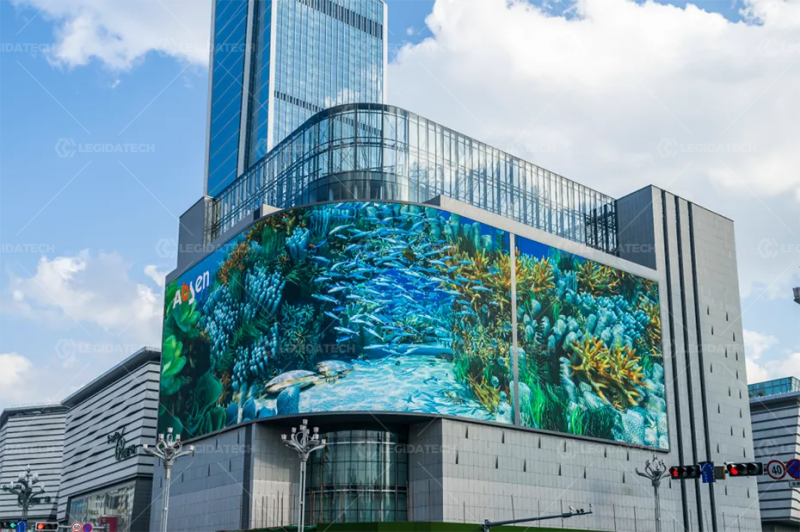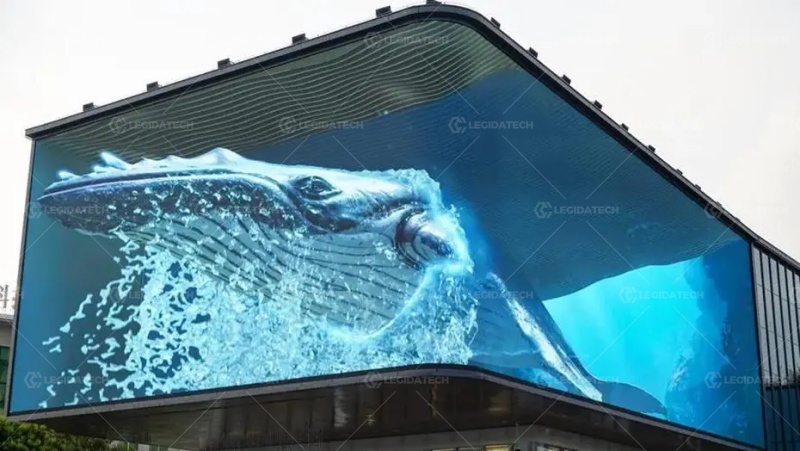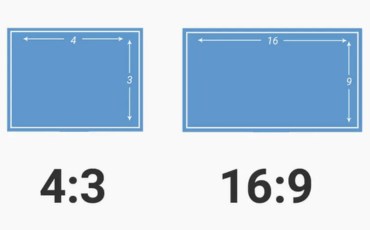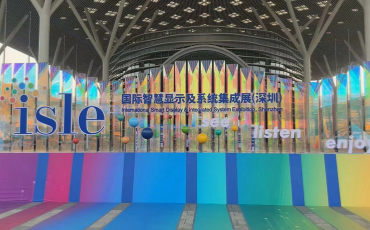I am a technical engineer of legidech LED display factory. I often have customers asking what is 3D led display and what is the appearance of 3D led display.
This complete guide to 3D led display will guide you through the full understanding of 3D LED display.
You can also follow this 3D LED display guide to make the 3D Display you need.
Chapter I: Basic Introduction to 3D LED Display
What is a 3D LED display?
To sum up: 3D LED display screen is a kind of LED display screen that can display three-dimensional images.
It uses the visual persistence effect of human eyes on images to quickly switch different three-dimensional images by controlling the brightness and extinction of LED lamp beads, thus forming a three-dimensional sense in front of human eyes.
Why use 3D LED display?
Compared with the traditional 2D LED display, the 3D LED display has a stronger three-dimensional effect, which can make the audience feel as if they were there.
It is not only energy-saving and environmentally friendly, but also has low power consumption, long life and easy recycling, which conforms to the concept of environmental protection.
In addition, the 3D LED display also has high brightness, can clearly display the image even in different environments, and has a wide viewing angle, the audience can watch from any angle.
Coupled with easy maintenance, LED lamp beads durable, low maintenance costs, can be said to be a powerful and practical display device.
What are the two types of 3D LED display?
There are two main types of 3D LED Display: one type is naked-eye 3D LED display, and the other is LED display that requires wearing 3D glasses to watch 3D video. We call it glasses-type 3D LED display.
The naked-eye 3D LED does not need to wear any special glasses, and the audience can directly watch the display screen with three-dimensional effect.
This technology uses the human eye’s ability to perceive depth through specific optical design and display methods to produce stereoscopic vision.
Glasses 3D Display: Glasses 3D LED display is usually the use of polarization, activity or 3D eyes and other technologies to achieve 3D effect.
Glasses 3D display technology can be divided into three types: chromatic aberration type, shutter type and polarization type (also known as color division method, time division method and light division method), chromatic aberration 3D display technology schematic diagram and polarization 3D display technology.
Naked Eye 3d led display VS glasses type 3dled display
1. Use glasses: The glasses-style 3D LED display needs to wear special glasses to watch 3D content, while the naked-eye 3D display does not need to wear glasses.
2. Viewing comfort: Since there is no need to wear glasses, the naked-eye 3D LED display is relatively more comfortable, because wearing glasses may cause visual fatigue and discomfort.
3. Viewing angle range: The glasses-type 3D LED display usually has a narrow viewing angle range, and the best 3D effect can only be obtained at the correct position and angle.
The naked-eye 3D display can provide a wider range of viewing angles, so that more viewers can enjoy the 3D effect at the same time.
4. Technical principle: glasses type 3D LED display usually uses polarization, movable or dichroic mirror and other technologies to achieve 3D effect.
The naked-eye 3D display uses different technologies, such as automatic parallax barrier to achieve 3D effects.
5. Cost: At present, the cost of naked-eye 3D LED display is higher than that of glasses-type 3D LED display, which is also a limiting factor for its application and popularization.
It should be noted that the naked-eye 3D LED display is not a solution for all scenarios and applications, and its advantages and limitations need to be evaluated according to specific needs.
How is the naked eye 3D LED display made?
The naked-eye 3 LED display is an outdoor display screen that adopts a folding angle design (including right angles and arc angles), combined with 3D video materials, allowing viewers to enjoy without any auxiliary equipment (such as 3D glasses, VR/AR equipment, etc.) Real 3D images.
This display is usually installed on the facade of the building, attracting potential customers who pass by to stop and watch the 3D brand story or product details and leave a deep impression.
Chapter 2: Naked eye 3D LED display solution:
With the continuous progress of science and technology, LED display as a new display technology, has been widely used in various fields.
Among them, the LED naked-eye 3D display has become the focus of the industry because of its unique technical principles and shocking visual effects.
If you are looking for naked eye 3D LED display solutions, LEGIDATECH engineers will explain LEGIDATECH naked eye 3D Display Solutions for you.
Naked-Eye 3D LED display is a cutting-edge display technology that uses the parallax characteristics of human eyes to allow viewers to see stereoscopic images with depth and space without wearing 3D glasses or helmets.
This system is actually a complex system composed of 3D stereoscopic display terminal, playing software, production software and application technology.
It integrates the knowledge of many high-tech fields such as optics, photography, electronic computer, automatic control, software pro-gramming and 3D animation production, and provides a solution of naked-eye 3D LED display screen with multi-field cross stereoscopic display.
The content displayed by the naked-eye 3D LED display seems to jump out of the screen vividly, and objects can emerge three-dimensionally outside the screen, or hide deep in the background, with rich colors, strong layering and three-dimensional sense, and lifelike details. Such as CAT in Tokyo.
It brings real three-dimensional visual enjoyment to the audience, not only the picture is vivid and lifelike, but also creates a beautiful and fascinating environment. The strong visual impact and immersive experience make it deeply loved by consumers.
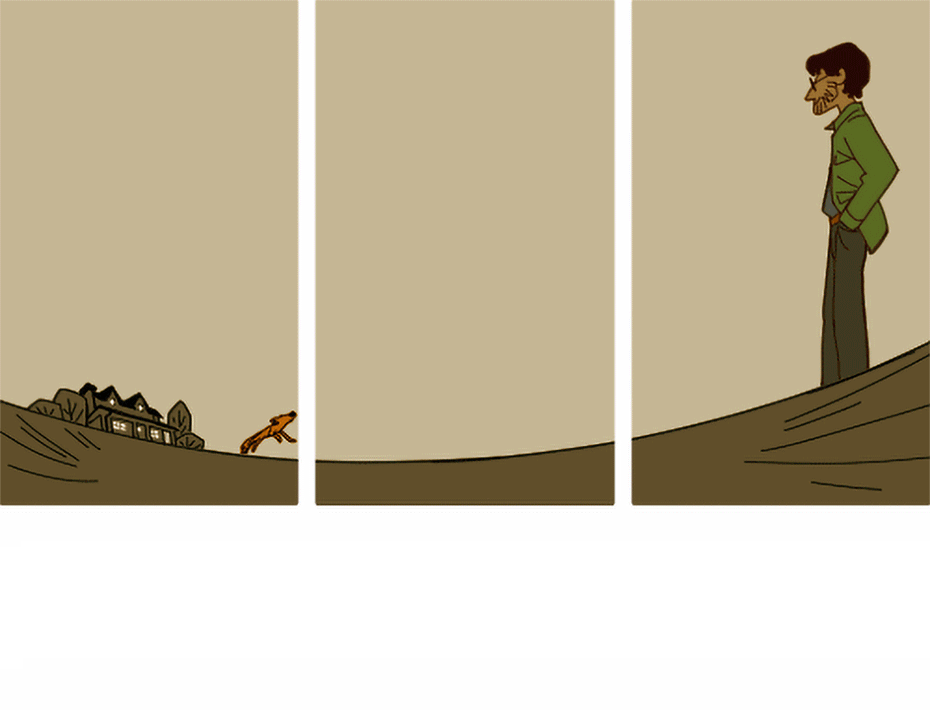
the realization principle of naked eye 3D technology
Naked-eye 3D technology, also known as autostereoscopic display technology, is a revolutionary visual experience.
It allows the audience to see realistic three-dimensional images directly with the naked eye without wearing 3D glasses or helmets.
The basic principle of this technology is to use the parallax principle to project the pixels corresponding to the left and right eyes to the left and right eyes of the audience respectively to form a three-dimensional image.
Parallax refers to the differences that occur when the same object is viewed from different angles. The brain processes these differences to determine the distance and depth of the object.
In fact, the origin of 3D technology can be traced back to the Renaissance concept of optical illusion.
Humans can perceive depth because the two eyes see different image information. With one eye closed, the position and angle of the left and right eyes will be significantly different, which is the basis of 3D technology.

Naked-eye 3D technology uses binocular parallax through parallax barrier technology to project the pixels of the left and right eyes to the corresponding eyes respectively, so that the brain generates a sense of depth, thus presenting three-dimensional images without auxiliary equipment, improving the viewing experience and promoting the development of display technology.
Common types of naked eye 3D LED display
The naked-eye 3D LED display is a new display technology, which mainly uses the LED display as the display device.
According to different application scenarios, it can be divided into two types: indoor and outdoor.
At the same time, based on its working principle and installation requirements, this type of display screen is usually designed into a variety of forms such as L-shaped, arc angle corner screen or curved screen according to different angles to adapt to various scenes and viewing requirements.

right angle corner led screen
the right-angle corner screen adopts an innovative L-shaped screen design.
Through seamless extension on two mutually perpendicular planes, it provides users with an ultra-wide field of vision that breaks through the tradition.
It is especially suitable for scenes requiring multi-dimensional visual effects, such as indoor corner display, commercial window design, etc., and can effectively improve space utilization and the layering of visual experience.
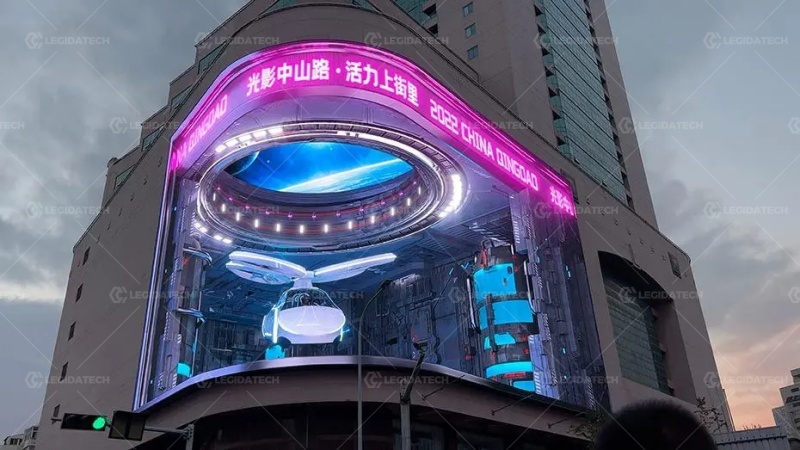
Arc Angle LED display
Der arc angle screen adopts a soft corner design, and the screen extends naturally along two intersecting but non-right-angled planes, bringing a smoother visual transition experience.
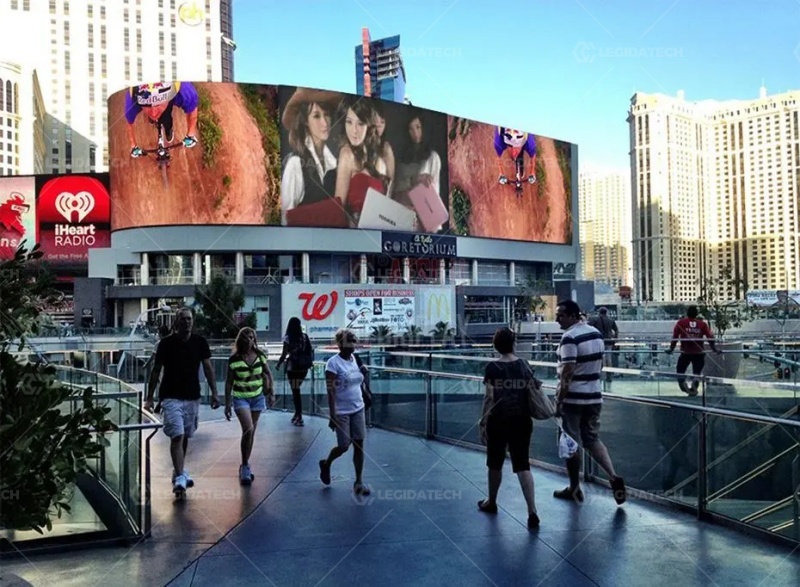
Curved led screen
By designing the LED display into a curved shape, the curved screen not only enhances the immersive perception of the screen, but also ensures uniform visual presentation from multiple angles.
Diversified naked-eye 3D LED displays, with unique visual presentation effects and flexible installation characteristics, are reshaping our visual experience and opening up new application prospects in the fields of commercial advertising, exhibition display and entertainment activities.

Analysis of the picture characteristics of naked eye 3D LED display screen
Naked eye 3D LED display screen picture strong three-dimensional sense-out of the frame visual effect
The reason why the naked-eye 3D LED display can bring a strong three-dimensional sense is not because of the angular design of the screen, but a technology called “out of the frame.
This effect cleverly deceives our eyes by making the main part of the picture seem to “fly” out of the limits of the screen, thus allowing the brain to perceive a deeper sense of three-dimensionality.
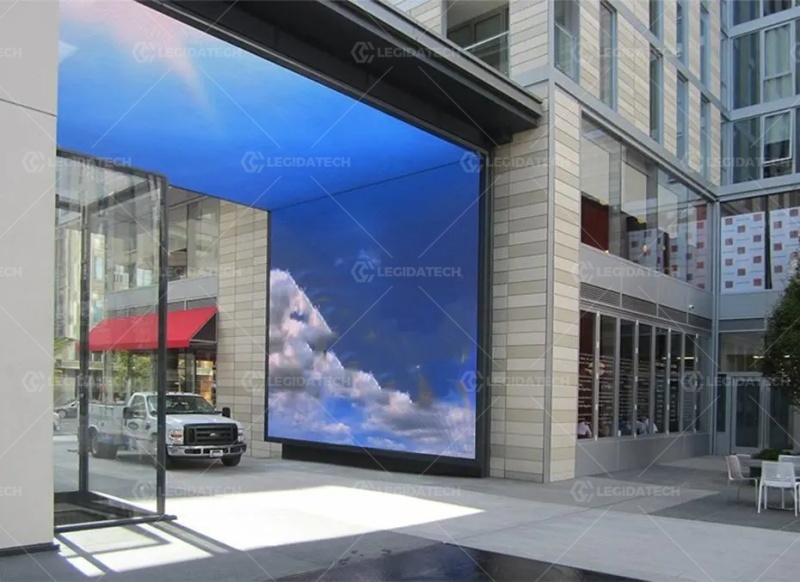
In daily life, the display devices such as TVs, mobile phones, and computers that we touch are usually confined within the frame, which makes people accustomed to thinking that the screen should be inside the frame.
Designers take advantage of this, in the picture to add the visual effect of the border. For example, the naked-eye 3D display screen in Chengdu Taikoo Li creates the illusion of a border By precisely controlling the brightness and boundary of the screen, and even deliberately making some areas of the screen completely black.
What’s more, the designer also “copied and pasted” the windows of the next building into the picture to further enhance the realism of the border.
When the subject of the picture exceeds the expected boundary, this contrast will bring a strong 3D stereoscopic effect, break through the limitations of traditional pictures, and bring immersive experience.

the unique performance of the naked eye 3D LED display screen picture-picture distortion phenomenon analysis
In fact, the current so-called Naked eye 3D technology is not really naked eye 3D. It can only show a strong sense of three-dimensionality when the audience is at a specific angle and a specially customized video is played.
If the angle or video content is wrong, the picture will be distorted.
For example, a straight line is straight from any angle on the plane, but in a special-shaped screen, it will maintain a straight line only when the audience’s eyes are at the same height angle as the straight line. Many netizens have also found such a “piercing” phenomenon.
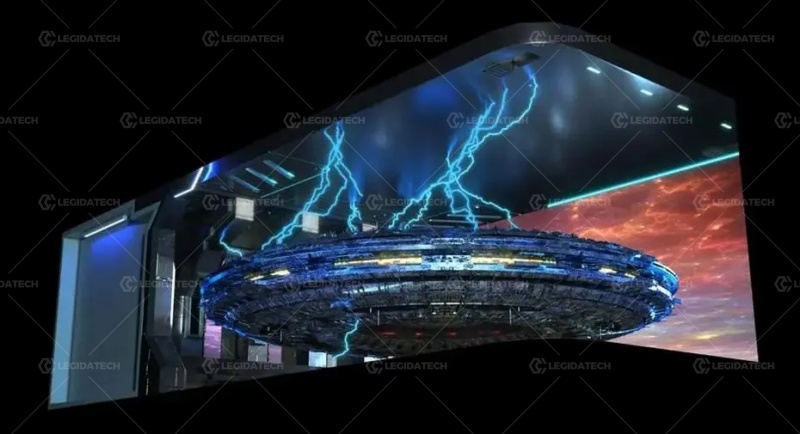
When we look up at the big screen on the square, in order to present the naked-eye 3D effect, we need to project the original straight content on the screen, so that it appears as a curved and angled arc in the audience’s perspective.
In this way, when the audience looks at it from a specific angle, they can see the correct proportion and shape. The content production of naked-eye 3D large screen is very complicated.
First, it is necessary to determine the viewing angle of the audience, including the height of standing, sitting and shooting with mobile phones, and combine these data to take an intermediate value.
Then, according to the structure of the screen, the space is extended, the scene is built, and finally the video suitable for large screen playback is rendered.
This process requires not only technical expertise and knowledge, but also a deep understanding of the viewer’s viewing habits and visual perception.
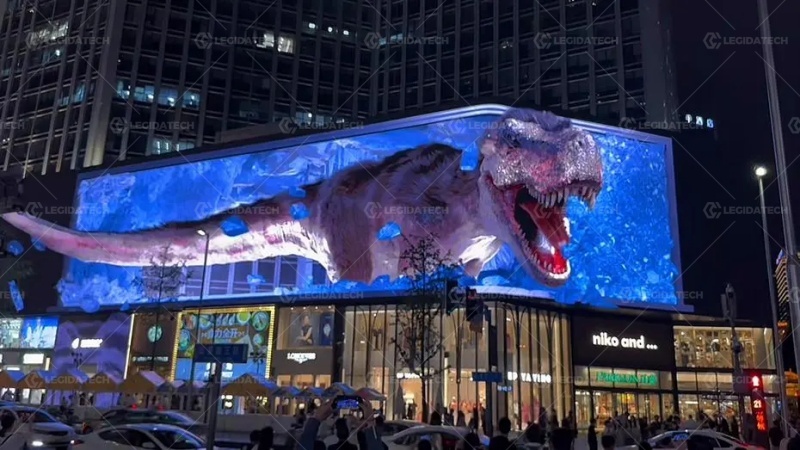
The depth charm of naked eye 3D LED display screen — the creation of Inner Space
Application of inner space technology in Naked eye 3D display. By using specific visual elements and design techniques on flat or curved surfaces, you can create a sense of depth and three-dimensional effect of the picture.
For example, adding a few lines to a dark plane can immediately show the depth of the space. Whether it is a large flat screen or a large curved screen, this technology is widely used.
Through carefully designed element layout and light and shadow effects, the interior of the screen seems to have a three-dimensional spatial structure, thereby enhancing the visual effect of the naked-eye 3D LED display. And the audience’s immersive experience.
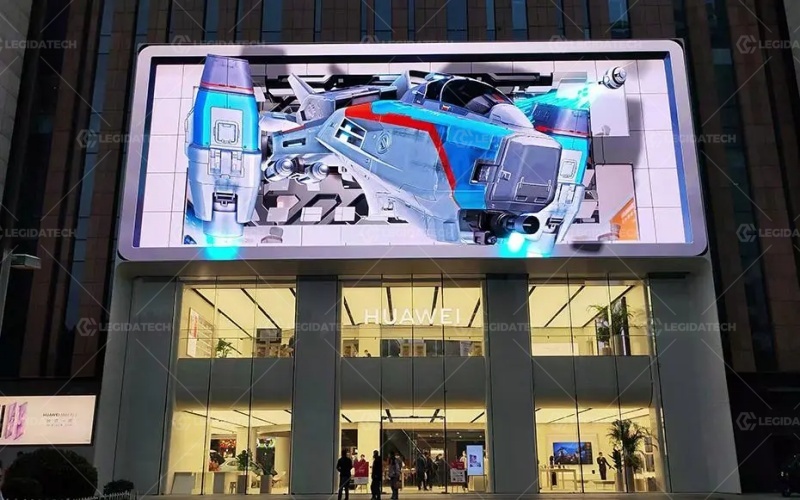
The naked eye 3D principle is made
the implementation principle of naked-eye 3D technology is mainly based on the parallax principle of human eyes, that is, by providing slightly different images for the left and right eyes to create a sense of depth.
The following is a detailed explanation of the naked eye 3D principle, expressed and summarized by points:
Binocular parallax principle:
there is a certain distance between the eyes of a person, so when looking at an object, each eye sees a slightly different image.
The brain processes these two different images to create a sense of depth, or three-dimensionality.

Naked eye 3D display technology:
the naked-eye 3D display technology uses special optical structures and display methods so that the left and right eyes can see different images at the same time without wearing any auxiliary equipment such as 3D glasses.
Mainstream technical means:
slit grating: A slit grating is added in front of the screen to separate the visual images of the left and right eyes through occlusion to form a 3D image.
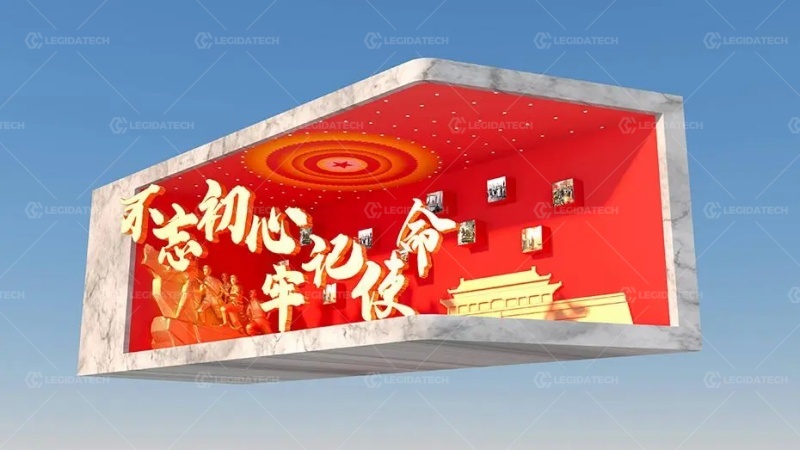
Lenticular lens: using the refraction principle of the lens, the pixels corresponding to the left and right eyes are projected to the left and right eyes respectively to achieve the effect of image separation.
Point to the light source: precisely controlling the two sets of screens to project images to the left and right eyes is also a method to achieve naked eye 3D.
Other technical means:
light Barrier Technology: A switching display screen, a polarizing film, and a polymer display layer are used to create a series of vertical stripes that form a parallax barrier so that the left and right eyes see different images.
Lorentz principle: light is refracted through tiny bumps on the screen, allowing the left and right eyes to see different pixels.
Technical challenges and developments: naked-eye 3D technology still faces some challenges, such as viewing angle limitation, Resolution Loss and manufacturing cost.
With the advancement of technology, the viewing experience of naked-eye 3D display devices will continue to improve, and the application field will be further expanded.
By simulating the parallax principle of human eyes, naked-eye 3D technology uses a variety of optical and display technologies to realize stereoscopic images that can be viewed without wearing auxiliary equipment.
This technology has a wide range of applications in entertainment, advertising, education and other fields.
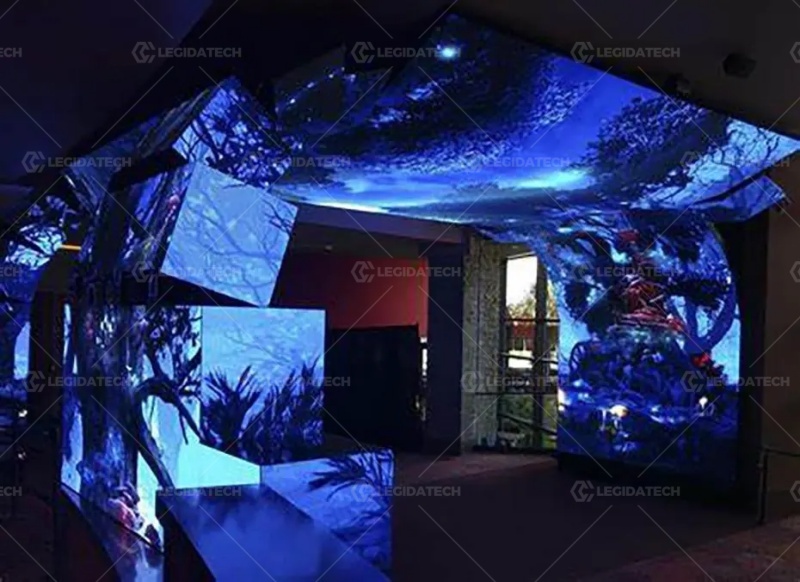
Features of naked eye 3D Display
The naked-eye 3D LED display provides a new three-dimensional image display method through a unique optical principle. Unlike traditional equipment, it can display three-dimensional images with high fidelity.
Its biggest feature is bright colors, whether indoor or outdoor, can maintain high saturation and contrast, vivid picture.
Especially in the outdoor light, it can still clearly display the gorgeous picture, bring a strong visual impact, has a high advertising and publicity value.
With its bright colors and three-dimensional effects, the naked-eye 3D display has become a star product in the new generation of display technology.
Naked eye 3D Display: stable and efficient, without fear of environmental changes
the naked-eye 3D display, a new type of display technology, is gradually changing our visual experience with its excellent performance and environmental adaptability.
It is particularly worth mentioning that it can operate stably in outdoor environments, thanks to its advanced natural light technology.
Natural light technology allows the naked-eye 3D display to work normally in the sun without being affected by strong light.
The introduction of this technology not only ensures the clarity and readability of the LED display under various lighting conditions, but also ensures that the human eye’s ability to distinguish images is not disturbed.
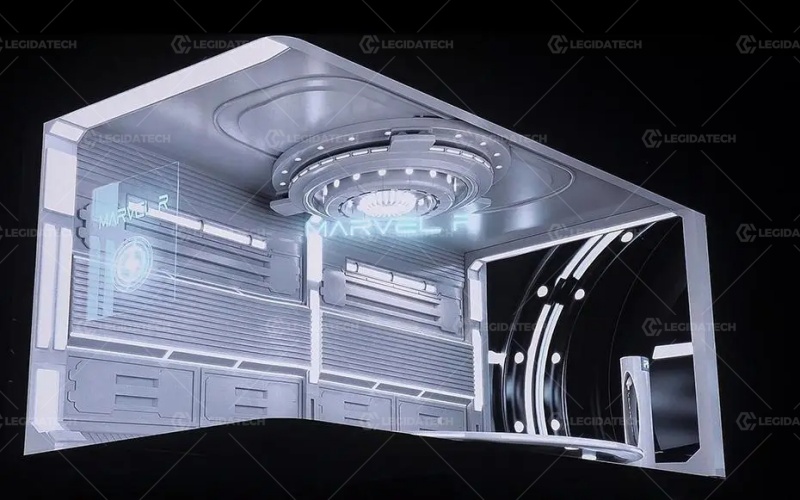
This feature of naked-eye 3D display makes it have broad application prospects in outdoor advertising, information dissemination and other fields.
Even in bright sunlight, it can maintain an excellent display effect and transmit clear and vivid visual information.
In addition, the naked-eye 3D display also has the characteristics of high brightness and high resolution, which makes it can provide excellent visual experience in various environments.
Moreover, due to the use of natural light technology, it will not have an adverse effect on human eyes, further enhancing the safety and comfort of its use.
With its excellent environmental adaptability and stability, the naked-eye 3D display breaks the use restrictions of traditional LED displays, and can provide excellent display effects whether indoors or outdoors.
The introduction of this innovative technology has undoubtedly injected new vitality into the field of modern visual media.
Chapter III: Nova control system: Naked eye 3D display solution
with the rapid development of digital multimedia, high-tech digital interactive creative screens are more and more applied to exhibition halls.
Among them, immersive exhibition hall has become a “new favorite” for its gorgeous display effect and all-round sensory experience.
With its super-large resolution and better display effect, LED display screen has become the main display scheme of immersive scenes, which is very popular in exhibition halls, pavilions and other scenes, subverting people’s inherent impression of traditional display, it is developing in a more diversified direction, especially with the continuous maturity of 5G, artificial intelligence, VR, AR and other technologies, more and more new technologies will be applied to LED displays, opening a new process of immersive experience.
This section details the naked-eye 3D display solution provided by Nova Control Systems.
Scheme Introduction
Scheme Topology Diagram
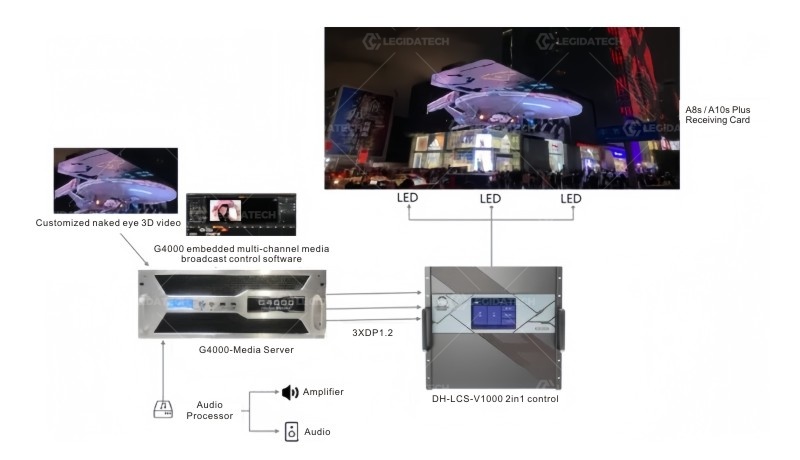
Scheme Overview and System Architecture
It is composed of LED naked eye 3D large screen, control system and video splicing equipment, multi-channel media broadcast control software and video server, audio system, synchronous video server platform and intelligent central control system.
Through customized three-dimensional content, it gives people a completely refreshing three-dimensional feeling.
LED naked eye 3D large screen, control system and video splicing equipment
the brightness of the LED screen is higher than that of the traditional display medium such as liquid crystal splicing, and can be applied to the naked eye 3D Display in high illumination environment.
And the viewing effect is good, and the advantage of seamless splicing is also very prominent, so when viewing at close range, the naked eye 3D LED display can present the overall display effect and immersive visual experience.
Naked-Eye LED 3D spatial vision technology is based on the splicing of large-resolution LED screens, using the principle of “deformation” to reorganize the composition of the video picture, and using this seemingly distorted projection method to create a real naked-eye 3D visual artistic expression.
Therefore, the LED display screen is no longer limited to the traditional flat screen with rectangular square structure, and should have more imagination space, so the 3D effect will be better.
Therefore, before the design, the shape setting of the LED display screen can be arbitrary, such as corner folding, lace, diamond edge wrapping, Triangle ending, etc.
And then combined with 3D software and video editing software to render customized playing materials, can achieve a variety of special-shaped screen naked eye 3D stereoscopic effect.
The control system and video splicing equipment adopt DH-LCS-V1000 series 2-in -1 Super splicing control and flagship receiving card A8s/A10s Plus to analyze, process and present the picture signal given by the playing system, and present the best display effect of definition, gray scale and color, so as to bring excellent stereoscopic visual experience.
Multi-channel media broadcast control software and video server
More professional multi-channel media broadcast control software and decoder can support 8K ~ 16K resolution video playback and low-level optimization of high code stream decoding.
However, the video server running professional multi-channel media broadcast control software needs to adopt professional graphics workstation (G4000 video server has built-in multi-channel media broadcast control software).
If it encounters a large screen, it also needs multiple professional graphics workstations and multi-graphics card frame synchronization cards to ensure strict synchronization of the whole screen, no sports tearing
customized 3D video material
what is closely related to this kind of naked eye 3D is the design and processing of video materials. First of all, the resolution of the materials should be customized point to point.
After selecting the main perspective, use the three-dimensional software to make three-dimensional structure according to the perspective relationship of the display model, use the three-dimensional software to build and simulate the three-dimensional perspective space, and cooperate with the professional editing and rendering software to render the three-dimensional effect on the video materials.
Finally, professional multi-channel media broadcast control software and video server are used to decode and play, and the optimal presentation of spatial three-dimensional dynamic effects is realized.
The following is an example of the production of four-fold video material:
Make the side and bottom picture stretching trend through 3dsMax
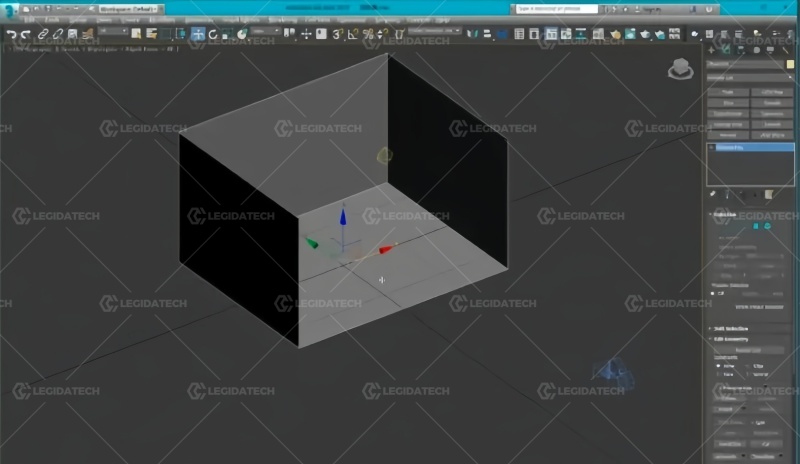
Clipping in the editing software PR, deformation
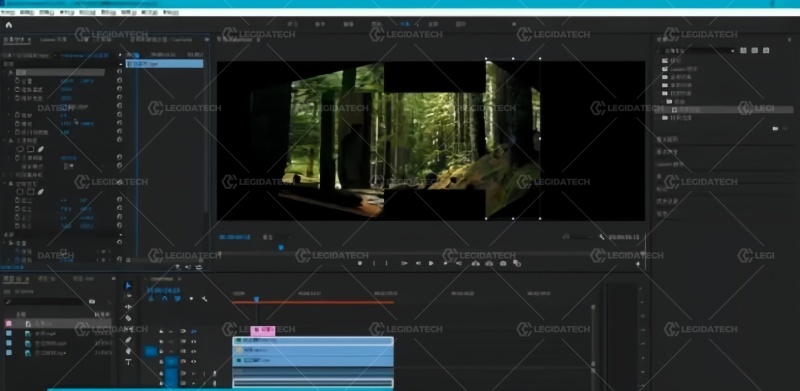
unity Producing Final Perspective Source

Intelligent central control system
all graphics workstations, LED large screen control system, control flat panel, sound system, power supply, machinery and other equipment are connected to Nova intelligent central control Vunit2000, which is interconnected by RS232 or TCP/IP, with one-key processing action, ms-level response performance, no packet loss and no delay in multi-point distribution.
Sound System
A hi-fi sound system that evenly covers a scene in a full frequency band is usually composed of a multi-channel audio processor, a power amplifier, a full-frequency audio, a subwoofer, etc.
Indoor Immersive Exhibition Hall Naked Eye 3D Display Control Scheme Core Advantages
although the video material in the “naked eye 3D” display is really crucial. However, it is still not enough to rely on video materials alone. It also needs to rely on the support of powerful functions of various products, cooperate with the high-definition solution of Nova A8s/A10s Plus flagship receiving card and the professional video control scheme of Nova H series 2-in -1 Super control, and have excellent performance in the display effect of screen definition, gray scale and color, so as to present excellent visual experience.
Nova A8s/A10s Plus flagship receiving card
in terms of hardware: Compared with traditional products, outdoor naked-eye 3D Display screen pays more attention to high refresh, high gray scale and high dynamic contrast. A8s/A10s Plus flagship receiving card has professional image quality engine technology, and pixel-level optimization enhances image quality.

Mainly through the following key technologies to present a more perfect effect: 22bit + technology
To achieve 64 times dynamic contrast enhancement, 0.001nits brightness precise control, when displaying low gray picture, dark details can still be fully revealed, the picture is clearer and sharper, and the image display is more delicate and uniform.
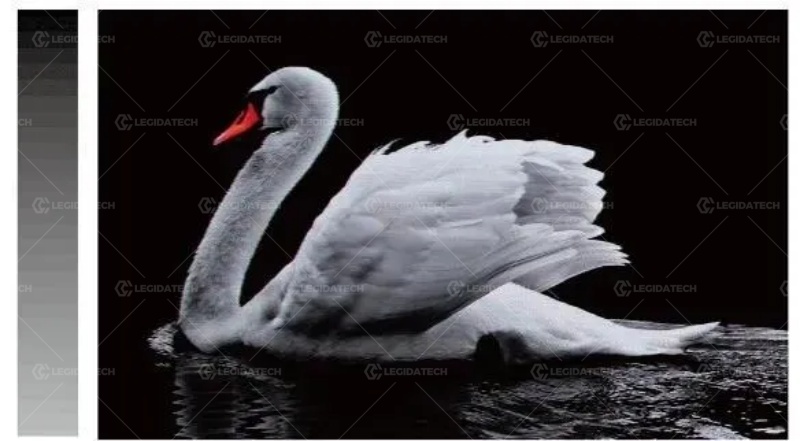
▲ Ordinary display effect, dark details are lost

▲ Open 22bit +, dark details are clear
fine Grayscale Technology:
professional optical instruments are used to carry out high-efficiency step-by-step calibration of the 16-bit 65536-level gray scale of the driver IC, effectively improving the phenomenon of low-gray color deviation, making the LED screen display more accurate gray scale and more natural color transition.
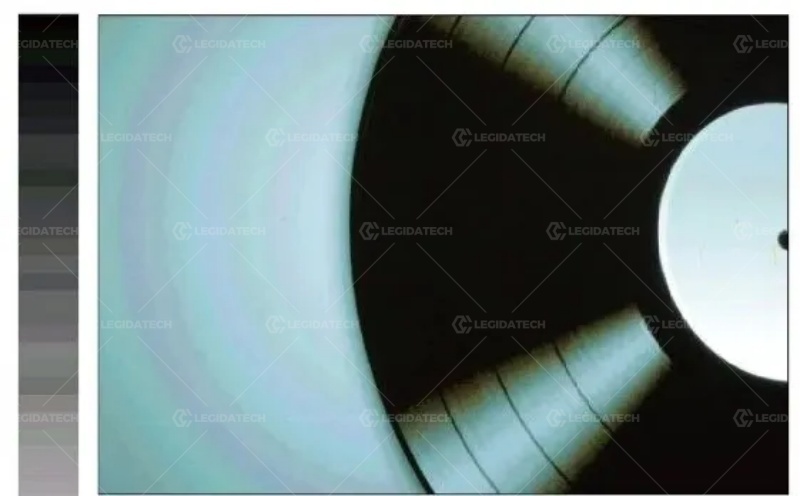
▲Ordinary display effect, gray scale is not accurate with color deviation

▲ 65536 step-by-step gray scale calibration, gray scale precision and fine picture quality
color Management Technology:
intelligent color management enables the color gamut of the display screen to perfectly match the color gamut of the video source, eliminates color deviation, especially the common phenomena such as reddish skin color, bluish sky, and over-green leaves, highly restores the original appearance of the real world and reproduces natural colors.
Nova H series 2-in -1 Super Control
in terms of hardware: the greater the resolution of naked-eye 3D full-color LED display screen, the more shocking the effect it presents.
At this time, the types, quantities and various wires of equipment such as splicers and sending cards used are more complicated.
The architecture of Nova H series 2-in -1 Super splicing control is more streamlined, which not only reduces the number of equipment, but also reduces 90% of wires (power lines, video signal lines, etc.), improve the stability of the project at the same time, compatibility issues will be solved.
The video processing flow in the same device can also be greatly optimized, which greatly reduces the delay time in the middle of video transmission, has higher stability and easier debugging.
A more professional and stable solution is presented mainly through the following features:

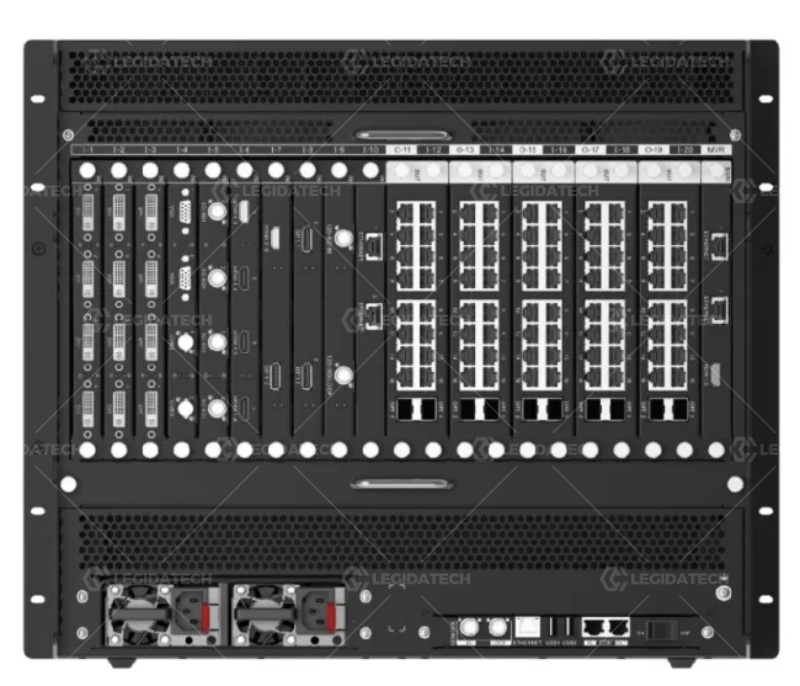
1. Support a complete and flexible 3D display control scheme.
Whether it is a PC or a mobile terminal, the operation is simple and clear. It can support fast visual control, WYSIWYG, industry-leading multi-user management and multi-permission allocation functions to realize multi-user collaboration and real-time data synchronization to ensure convenient operation and safe protection of user data.
2. Support input EDID management and output timing custom settings to meet diverse customer needs
3. Full link true 4K processing support, the latest 10bit transmission technology, and HDR High Dynamic Range Display
4. The industry is the first to highly integrate the plug-in splicer and the sending card.
The system architecture is more streamlined, saving at least 80% of wires such as DVI lines and power lines. The on-site construction wiring is more convenient and the computer room is cleaner.
5. A single device can replace 56 2k sending cards in the traditional scheme at most. A single device can support up to 200 network ports for output.
It can directly dock LED receiving cards and has a maximum load 0.13 billion (30K * 4K), which greatly saves cabinet space and cost and improves system compatibility, stability and convenience.
6. A single 2-in -1 output board with 20 network ports outputs, with a maximum load of 13 million and a width and height of 10752. The load is not limited by DVI interface, which is far greater than the 9.2 million load of the traditional scheme.
7. Multiple two-in-one output boards do not need to be cascaded, debugging has never been so simple, unified brightness adjustment is simple and efficient, and it is done in one go.
8. Compared with the traditional scheme, from the signal source to the LED screen display, the overall delay of the system is reduced by at least 2-3 frames, with excellent results
9, single output interface up to 16 windows, single machine maximum 160 window, can be arbitrary cross-screen roaming, not limited by the output interface, the utilization rate is ultra-high
10. Intelligent editing of 2000 user-defined scenes on a single machine, seamless switching of radio and television grade fade-in and fade-out, and more control of scene rounds
Chapter IV: Glasses type 3D LED display solution:
glasses 3D display technology can be divided into three types: color difference type, shutter type and polarization type (also known as color division method, time division method and light division method), color difference type 3D display technology schematic diagram and polarization type 3D display technology schematic diagram as shown in Figure 4-1.
The naked-eye 3D display technology can be divided into three types: lens array, barrier fence and pointing light source, and the principle and imaging effect of each technology have certain differences. T
his section introduces the technology of LED Display Display 3D effect and the debugging method of simple project.
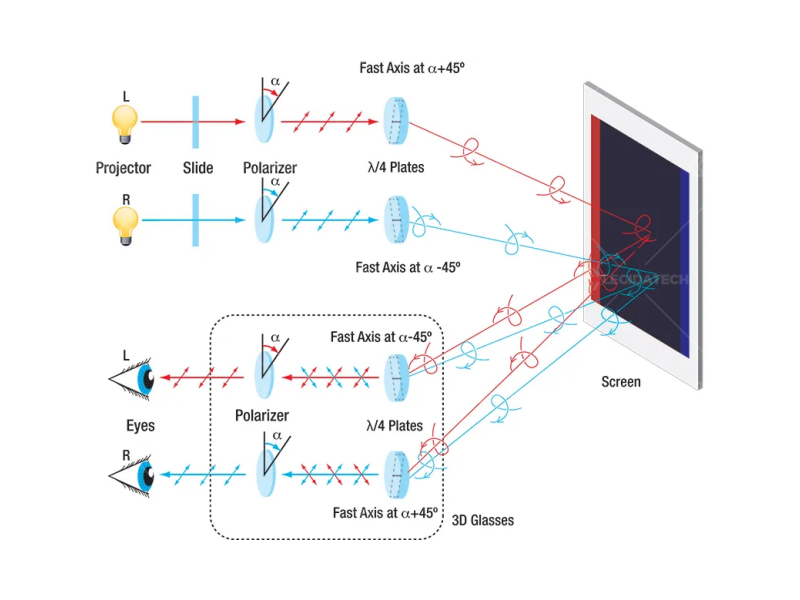
4-1
At present, LED displays mostly use shutter technology to achieve 3D effects. This technology mainly realizes the 3D effect by improving the refresh rate of the picture.
By dividing the image into two frames, two groups of pictures corresponding to the left eye and the right eye are formed, so that they can be displayed continuously and interlaced.
At the same time, the signal transmitter synchronously controls the switch of the left and right lenses of the shutter-type 3D glasses, so that the left and right eyes can see the corresponding picture at the correct time.
Shutter 3D display technology schematic diagram 4-2 as shown .
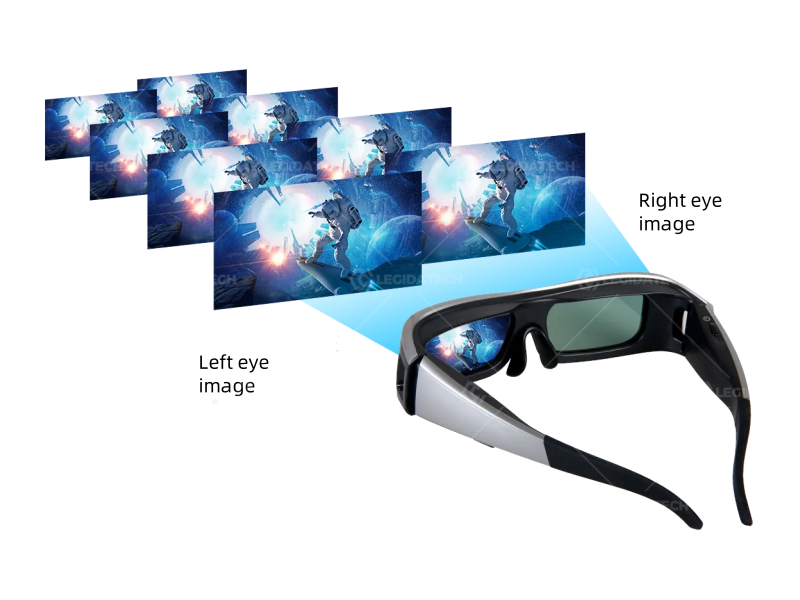
4-2 Shutter 3D display diagram
System architecture of 3D display technology
in order to realize the display of 3D effect, the system architecture of LED display screen is more complex than that of ordinary system architecture, mainly in two aspects:
① There must be video equipment and LED display controller that can play and process 3D video sources.
② There are transmitting devices that send 3D signals and glasses that receive 3D signals.
Specific to the LED display has the following requirements.
1. Hardware Requirements
(1)3D video source equipment.
Computer, video processor, Video Splicer and other equipment used to provide 3D video source selection, need to consider the size of the screen, the input source interface of the controller, the 3D mode used in the project.
(2) LED display controller.
The function of the LBD display controller that supports 3D video source processing is to transmit the front-end 3D video to the screen after processing.
It should be noted that not all LCD display controllers support 3D functions.
In addition, it is also necessary to use one or more devices of the same model according to the size of the screen.
(3) Receiving card and screen body.
In theory, all receiving cards support 3D function, but when designing the project, we must consider the problem that the load of receiving cards will be reduced in 3D working mode.
When setting the screen wiring, it is necessary to consider the load capacity and 3D mode of the main control equipment as a whole.
(4)3D transmitter.
The function of the 3D transmitter is to send the 3D signal processed by the controller to the 3D glasses, so that the LED display and the 3D glasses can switch the left and right eye images at the same time.
So this device is one of the necessary devices to achieve 3D effects, such as Nova Nebula EMT200 or third-party launchers.
(5)3D glasses.
3D glasses are devices that receive 3D field-changing signals, and the opening or closing of the left and right glasses are controlled by 3D glasses to achieve synchronization with the LED display screen.
The device is also one of the necessary equipment to achieve 3D effects, such as the Nova Nebula MX50 or third-party glasses.
System Connections
the basic architecture of the 3D effect LED display screen adds a 3D transmitter on top of the original basic control architecture, and uses special front-end video processing equipment.
The following is an example of Nova Nebula MCTRL1600 and EMT200 to explain the regular 3D project that can be loaded by a single controller, and the front-end video source can be played by a computer.
More complex, large, immersive projects will be covered in an advanced course.
3D transmitter (EMT200 as an example below) generally has two network ports, one is the input network port, and the other is the output network port. There are two connection modes in the whole system.
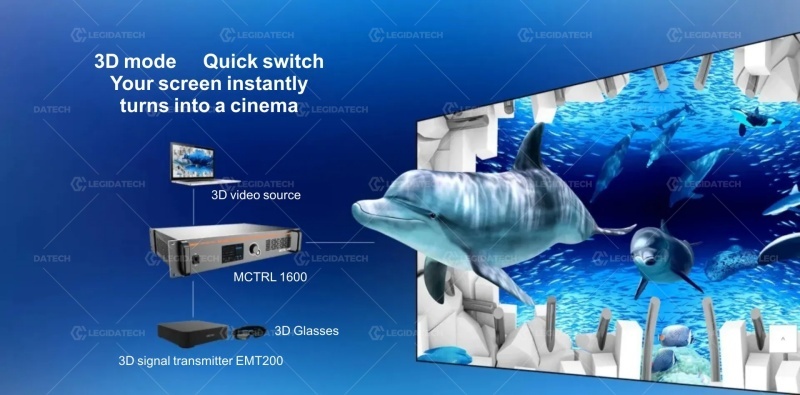
(1)EMT200 is connected to the rear of any receiving Card. The connection mode of EMT200 is as shown in Figure 1. 4-3 show.
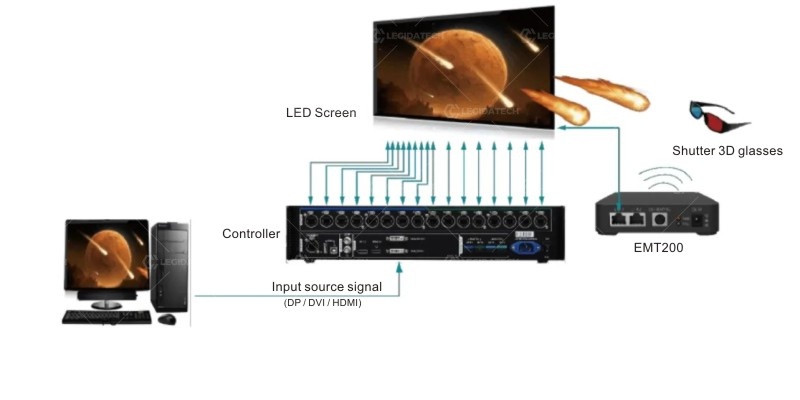
4-3 EMT200 connection mode 1
(2) EMT200 is connected between the LED display controller and the receiving card, any network port can be used, EMT200 connection Mode 2 is shown in the figure 4-4 shown.
Constraints on the load capacity of the system

4-4 EMT200 connection mode 2
1. LED display controller with load limit
the calculation formula for the single port load of the LED display controller is 1Gbx port efficiency = single port load capacity x frame rate x (red bit depth + green bit depth + Blue bit depth) under normal video source format, the frame rate of the video source is 60Hz.
At this time, the calculated single port load capacity is 650000 pixels. But in the shutter 3D display technology, LED display controller will be the original 60Hz .
the video source is cropped to left-eye video and right-eye video, and then the two 60Hz videos are superimposed to generate a special 120Hz video source.
Through the above formula, it can be concluded that the load capacity of the single network Port needs to be halved, that is, the load capacity of the single network port is 325000 pixels.
Take Nova Nebula as an example, the version requirements for each master 3D band load and support 3D function are shown in the table. 4-5 show.
Each master 3D load range and support 3D function
|
main control model |
2D LED display with load |
3D LED display with load |
whether to support scaling |
|
MCTRL1600 |
9.2 million pixel |
4.6 million pixel |
no |
|
MCTRL4K |
8.8 million pixel |
4.4 million pixel |
no |
|
K16 |
10.4 million pixel |
5.2 million pixel |
yes |
|
VX16 |
10.4 million pixel |
5.2 million pixel |
yes |
Since the input source interface and 3D function implementation modules of each type of LED display controller and 2-in -1 device are different, there will be some differences in the configuration of 3D schemes and parameters of different types of main control devices.
For specific differences, please refer to Nova product manual.
2 Receive cassette load limit
In theory, the receiving cards all support 3D functions, but due to the improvement of frame rate, the carrying capacity of the receiving card in 3D projects needs to be reduced in general.
The specific reduction value is related to the working mode of the receiving card, the depth of the input source, the type of lamp board chip, etc.
Take the Nova Nebula as an example, the 3D function load parameters of each type of receiving card are shown in the table.As shown in 4-6.
Each model Nova receiving card 3D function with load parameters
|
nova Receiving Card |
regular with load/Pixel |
PWM chip 3D with carrier pixel |
|
A5S PLUS |
382*512(8bit) 384*256(12bit) |
16 sets of data: 416*256 20 sets of data: 320*256 24 sets of data: 384*256 28 sets of data: 384*256 32 sets of data: 432*256 |
|
A7S |
512*256 |
16 sets of data: 256*256 20 sets of data: 192*256 24 sets of data: 192*256 28 sets of data: 224*256 32 sets of data: 256*256 |
|
A8S |
384*512 |
16 sets of data: 384*256 20 sets of data: 320*256 24 sets of data: 336*256 28 sets of data: 336*256 32 sets of data: 384*256 |
Receive cassette loading precautions are as follows:
(1) The load of the receiving card will change according to the update of the firmware program version.
The load of the receiving card of each model here is for reference only, and the load of the latest firmware version of the receiving card shall prevail.
(2) Some special driver chips need special attention when setting up 3D, such as 2055/2059, 2065/2069. When the 3D effect is turned on, the deframing interval mode in the extended attribute needs to be turned on.
In addition, some driver chips that temporarily do not support field frequency adaptation need to be supported by customized special programs.
(3) if the receiving card models not included in Table 4-2 or the receiving card products of other companies are used in 3D projects, you can refer to the halving of the receiving card when calculating the receiving card load.
(4) When designing the receiving card scheme, it is necessary to consider not only the total carrying capacity of the receiving card, but also the carrying capacity of each set of data, neither of which can exceed the limit.
Classification of 3D video sources
you must use a 3D video source to play 3D videos. The left and right video sources are shown in Figure 4-6. The video sources in Figure 4-6 are common left and right video sources.
In any frame of the picture is divided into left and right two pictures, careful observation can be found that the two pictures are not the same, that is, one for the left eye of the picture, the other for the right eye of the picture.
Therefore, its resolution is twice as large as that of ordinary video sources. For example, for a standard 1080p-sized left-right format 3D video source, the actual distribution rate of each frame is 3840 pixels × 1080 pixels (left-eye 1920 pixels × 1080 pixels, right-eye 1920 pixels × 1080 pixels).
Similarly, there are 3D video sources in up and down format, I .e. the left and right eye pictures are arranged up and down, so the resolution of the standard 1080p video source is 1920 pixels x 2160 pixels.
There is also a video source format called the front and back format, also known as the continuous frame format, which is obtained by cutting the left eye picture and the right eye picture and superimposing them in odd-even order, so the video source itself is already 120Hz frame rate.

3D Display Settings
the following takes the Nova Nebula MCTRL1600 as an example to introduce the setting steps of 3D display. MCTRL1600 and EMT200 are connected to the control system according to the system connection mode shown in Fig. 4-63 or Fig. 4-64.
There is no specific model limit for the receiving card. During the implementation of the whole scheme, it should always be noted that the load capacity of the single network port of the controller is halved, and the load capacity of the receiving card and the load capacity of each group of data are halved accordingly.
The two types of input source interfaces 1600 by MCTRL are DVI and DP, as shown in Figure 4-7.
Different types of input source interfaces have different requirements and parameter settings for input sources when implementing 3D functions. The settings for DVI and DP input source interfaces when implementing 3D functions will be introduced respectively.

3D function setting under DP interface
requirements for input source: There are three situations according to different video source formats under DP interface.
(1) When the video source is in left and right format (the input source is 50Hz2 or 60Hz), the resolution of the input source is required to be twice the screen width.
For example, when the actual screen size is 1920 × 1080, the input source size must be 3840 × 108.
(2) When the video source is in upper and lower format (the input source is S0Htz or 60HTZ), the distribution rate of the input source is required to be twice the screen height.
For example, when the actual screen size is 1920 × 1080, the input source size must be 1920X2160.
(3) When the video source is in front and back frame format (the input source is 100Hz or 120Hz), the distribution rate of the input source is kept the same as the screen size.
For example, when the actual screen size is 1920x 1080, the input source size must be 1920x 1080.
Example of DP interface use: a single MCTRL1600 uses DP interface to display a 3D hardware connection through NovaLCT software.
In the dialog box of “display screen configuration-COM99” of NovALCT software, set the sending card, check the “Enable 3D” checkbox in the “sending card” tab, and click the “set 3D parameters” button to enter the specific settings, open the setting 3D interface as shown in Figure 4-8.
 Open the setting 3D interface
Open the setting 3D interface
After entering the sending card 3D parameter setting, you need to set parameters such as video source format, left and right eye priority and right eye starting position. The 3D parameter setting interface is shown in Figure 4-9.
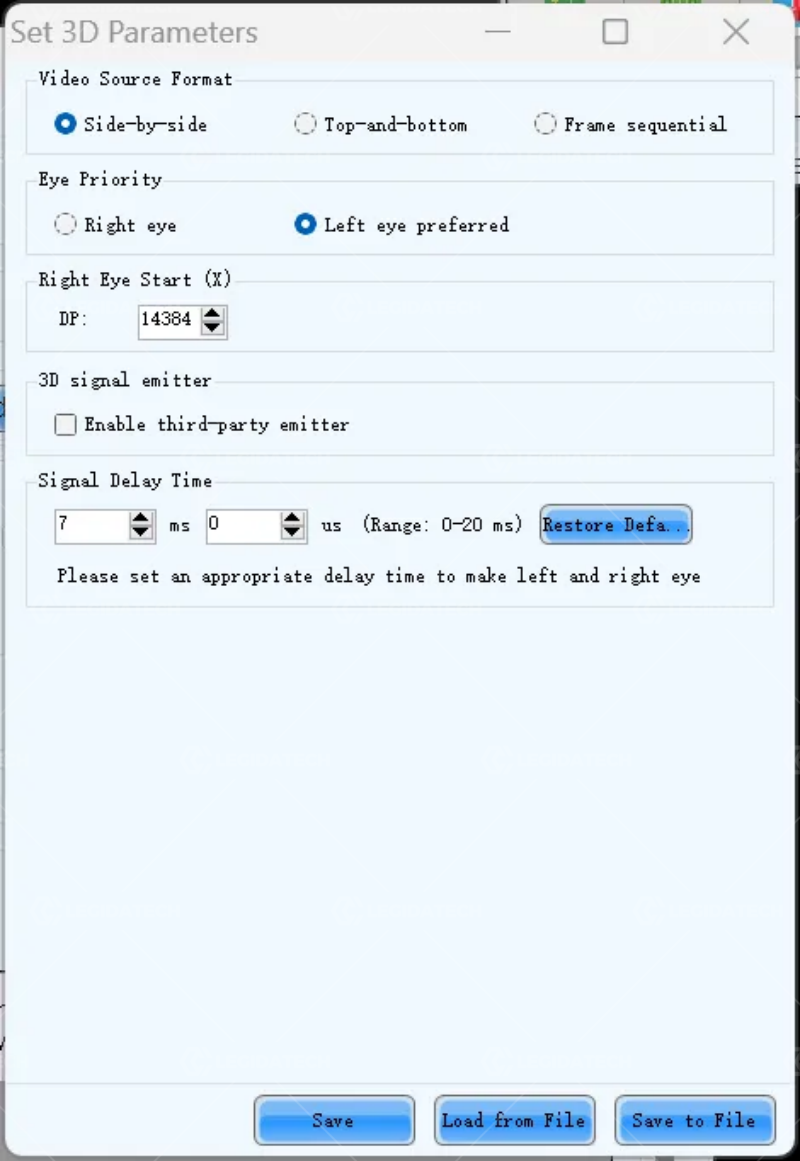
3D parameter setting interface
Video Source Format: Select the video source format.
Left and right eye priority: the selection is related to the synchronization signal received by EMT200 for the first time. It needs to be selected on the spot with reference to the actual effect. There is no need to change it after selection.
Right eye starting position (X): The actual width or height of the screen.
3D signal transmitter: If you do not use a third-party transmitter, you do not need to select; If you use a third-party transmitter, turn on this item.
If the selected third-party transmitter also needs to be connected to the EMT200, a connection manner is consistent with the foregoing description, and the third-party transmitter needs to be connected to a 3D signal output interface of the emt200.
Signal delay Time: In general, the delay time is the default. If the 3D effect is not obvious on site, this parameter can be fine-tuned.
(1) The video source is in left and right format.
① Assuming that a 3D picture needs to be displayed in a screen of 3840 pixels × 1080 pixels, the front-end processor or graphics card is required to output a 3D video source with a resolution of 7680 pixels × 1080 pixels (twice the width of the screen and including left and right eye pictures) to connect to the DP interface of mctrl1600.
② open the 3D parameter setting interface in the sending card interface of NovaLCT software, select the left and right format, the starting position of the right eye is 3840, set other 3D parameters (left and right eye priority, etc.), and the 3D parameter setting interface (left and right format) of DP interface is shown in Figure 4-10.

2) The video source is in top and bottom format.
① Assuming that a 3D picture needs to be displayed on a 3840 pixel x 1080 pixel screen, then the front the end processor or video card outputs a 3D video source with a resolution of 3840 pixels x 2160 pixels (twice the height of the screen body and including upper and lower pictures) to connect to the DP interface of mctrl1600.
② Open the 3D parameter setting interface in the NovaLCT software sending card interface, select the upper and lower format, the starting position of the right eye is 1080, set other 3D parameters (left and right eyes are given priority, etc.), and the 3D parameter setting interface of DP interface (upper and lower format) as shown in Figure 4-11.

3) video source for before and after the format.
① Assuming that a 3D picture needs to be displayed on a screen of 3840 pixels x 1080 pixels, the front-end processor or graphics card needs to output a 3D video source with a resolution of 3840 pixels x 1080 pixels (consistent with the screen resolution, 100Hz or 120Hz) to connect to the DP interface of mctrl1600.
② open the 3D parameter setting interface in the sending card interface of NovaLCT software, select the front and back format, and set other 3D parameters (left and right eye priority, etc.).
The 3D video source of the front and back frame format does not need to set the starting position of the right eye. The 3D parameter setting interface (front and back format) of DP interface is shown in Figure 4-12.

3D parameter setting interface of DP interface (front and back format)
Chapter V. Summary:
Whether it is a naked-eye 3D LED display or a glasses-type LED display, they all need to customize the 3D video source material and a control system with the function of supporting the 3D display.
3D LED display, this cutting-edge display technology, with its unique dynamic playback function, brings a rich and colorful visual experience to the audience.
Whether It is vivid animation, attractive advertisements, or other various video content, it can be presented in a three-dimensional and realistic way, making the audience feel as if they were there.
The 3D LED display has a wide range of uses. It can be used for interior decoration to add a sense of technology and modernity to the space, and it can also be used as an outdoor decoration to attract the attention of pedestrians.
In the indoor environment, 3D LED display is often used as a unique decorative material to show the plane image in a three-dimensional way, adding a different kind of color to the indoor space.




